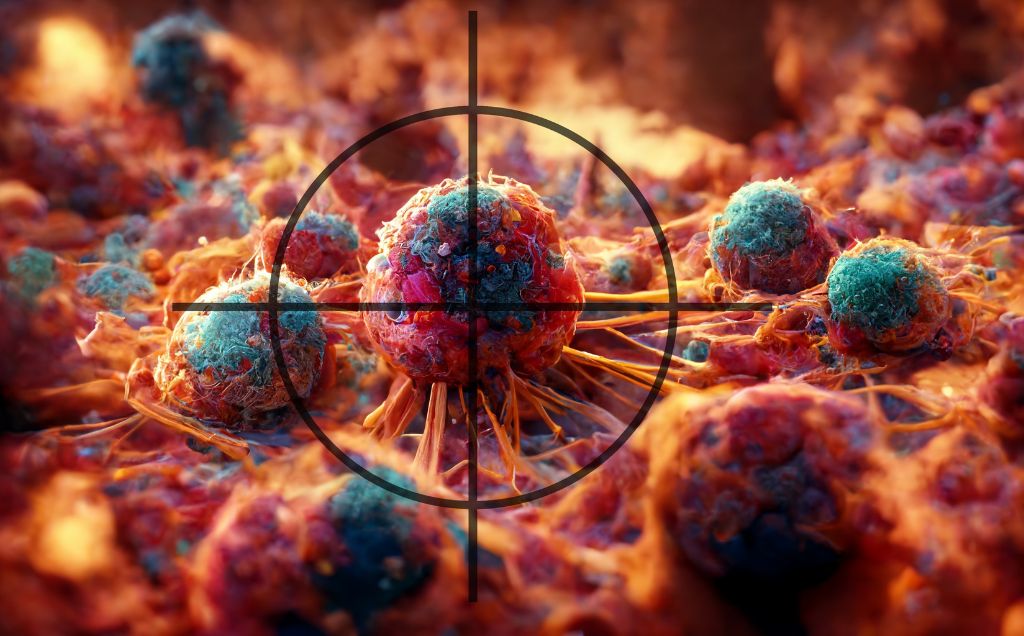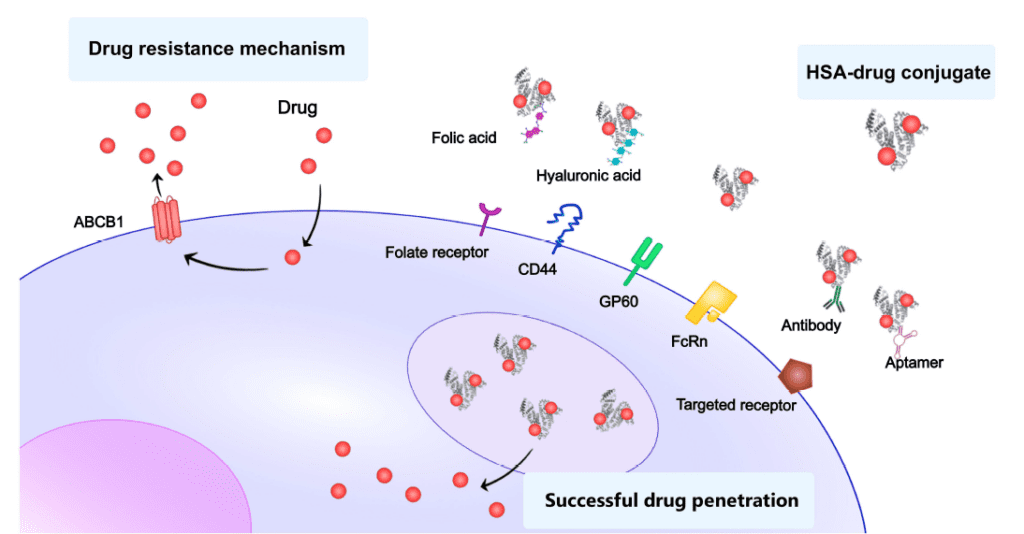- Home
- Albumin in Drug Delivery: Cancer’s Unexpected Achilles’ Heel
Albumin in Drug Delivery: Cancer’s Unexpected Achilles’ Heel
Published on 9 April 2025
The Hidden Power of Albumin - Outsmarting Cancer's Drug Resistance
Reading time: 4 minutes
Share this article:

Cancer cells have a sneaky habit. Just when it seems chemotherapy is getting the upper hand, they adapt, pumping drugs out faster than they come in. It’s called multidrug resistance (MDR), and it’s a major roadblock in treating cancers like breast, lung, and pancreatic. But what if the solution to outsmarting these stubborn cancer cells was hiding right in our bloodstream all along?
Enter Human Serum Albumin (HSA)
HSA isn’t just another protein—it’s a natural transport superstar, accounting for about 60% of plasma proteins. Beyond shuttling nutrients, albumin’s non-toxic, biodegradable nature positions it perfectly as a medical Trojan horse. Cancer cells depend heavily on nutrients to fuel their rapid growth, and albumin is one of their favorites.
Cancer’s Greatest Weakness—Its Appetite
Cancer cells’ insatiable appetite for albumin can be turned against them. In their recent review, researchers at Pomeranian Medical University describe how human serum albumin (HSA) nanoparticles cleverly bypass cancer cells’ defense mechanisms. Instead of being expelled by resistance pumps like MDR1—think of these pumps as stubborn gatekeepers—albumin-bound drugs slip inside unnoticed, appearing more as nutrients than medicine.
How exactly does this happen? Albumin nanoparticles primarily enter cancer cells through receptor-mediated endocytosis, a process where cell-surface receptors such as gp60 and Secreted Protein Acidic and Rich in Cysteine (SPARC) facilitate targeted uptake. By leveraging this natural pathway, albumin nanoparticles effectively circumvent the MDR1 resistance pumps and deliver chemotherapy directly into cancer cells.

Real-World Application: How Albumin is Already Changing Cancer Therapy
- Abraxane: Approved in 2005, Abraxane set the stage by combining paclitaxel with albumin to tackle breast cancer more effectively than traditional formulations. However, patients receiving Abraxane may still experience significant side effects such as neuropathy and myelosuppression, highlighting an ongoing need for further improvement in nanoparticle drug delivery.
- Active Targeting: By attaching targeting molecules like folate or antibodies to albumin nanoparticles, treatments directly pinpoint cancer cells, sparing healthy tissue and reducing side effects.
The Science Behind the Magic
How exactly does albumin accomplish this?
- Passive targeting via the EPR Effect: Tumors naturally accumulate nanoparticles because their vessels are unusually leaky, known as the Enhanced Permeability and Retention (EPR) effect. Albumin-based nanoparticles exploit this property, significantly boosting drug delivery at the tumor site without complicated targeting systems.
- Versatility of Albumin: HSA can bind both hydrophobic and hydrophilic drugs and even imaging agents, providing flexibility to customize treatments.
A Practical Viewpoint: The Need for Recombinant Albumin
While native albumin (from human plasma) has shown tremendous promise, it’s not without its limitations, including supply constraints and safety concerns. Here’s the deal: Recombinant human albumin, like InVitria’s portfolio, offers a scalable, safer alternative. It eliminates concerns around blood-derived contamination and ensures consistency in large-scale pharmaceutical applications.

Why Does This Matter?
Consider this—low albumin levels (hypoalbuminemia) are common in cancer patients, often due to nutritional deficiencies or tumor progression, and have been directly linked to increased chemotherapy-induced toxicity (chemotoxicity) and poorer treatment outcomes (Arrieta et al., 2010). While drug-loaded albumin nanoparticles (e.g., Abraxane) are designed for targeted drug delivery rather than nutritional albumin replenishment, addressing hypoalbuminemia itself through appropriate nutritional interventions or potentially recombinant albumin administration could conceptually help manage chemotoxicity and improve patient tolerance to chemotherapy. However, the direct therapeutic use of recombinant albumin specifically for chemotoxicity remains an area requiring further clinical exploration.
The Bottom Line? Albumin is More Than Just a Carrier—It’s a Game Changer
Cancer treatment desperately needs smarter, safer strategies. HSA-based therapies harness the biology of cancer cells, turning their greatest strength—their voracious appetite—into their biggest vulnerability.
What breakthroughs could recombinant albumin technology unlock next in the fight against cancer drug resistance and toxicity?
So what’s next? The future lies in recombinant albumin technology. If you’re interested in discovering how InVitria’s recombinant albumin products can enhance drug formulation strategies and tackle cancer resistance, let’s connect. Contact us today.
Explore more about recombinant human albumin and join the conversation about transforming cancer therapies through smarter drug delivery solutions.
Read the Paper: Wolf in Sheep’s Clothing: Taming Cancer’s Resistance with Human Serum Albumin?
Stay at the Forefront of Innovation
At InVitria, we’re dedicated to pushing the boundaries of biomanufacturing with advanced, recombinant, and chemically defined solutions. Our team is constantly innovating to support the industry’s evolving needs. Sign up for our newsletter to get early access to product updates, expert insights, and exclusive content.
Featured Solution

Optibumin 25 ® – Recombinant Human Serum Albumin in Bags
Optibumin 25 in bags supports closed-system biomanufacturing with enhanced safety, consistency, and scalability. This high-purity, recombinant, animal-free albumin solution eliminates contamination risks from animal- and human-derived materials, ideal for advanced cell therapy and vaccine workflows. Its chemically defined formulation promotes stable cell growth, viability, and process reliability.
Footnotes
References
- Stukan, I., Grześ, M., Borysławski, K., Kaczorowska, A., Tarnowski, M., & Bajdak-Rusinek, K. (2024). Wolf in sheep’s clothing: Taming cancer’s resistance with human serum albumin. Pharmaceutics, 16(3), 333. https://doi.org/10.2147/IJN.S500997
- Arrieta, O., Michel Ortega, R., Villanueva-Rodríguez, G., Serna-Thomé, M. G., Flores-Estrada, D., & Diaz-Romero, C., et al. (2010). Hypoalbuminemia during chemotherapy predicts severe chemotherapy-induced toxicity in patients with metastatic gastric and colorectal cancers. Medical Oncology, 27(3), 825-830. https://doi.org/10.1007/s12032-009-9292-9